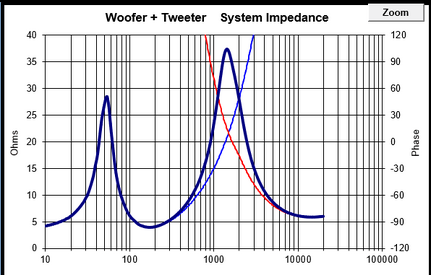This example, if I am not mistaken, could provide a benefit in the following way:
Although the two amps are handling the same signal (voltage), the LF amp delivers very little HF current into the LF part of the crossover+woofer, and the HF amp delivers very little LF current into the HF part of the crossover+speaker. So each amp can now deliver mroe power into its respective speaker section and greater volume without overload is possible.
While sort of correct in that each amp would only "see" the load of the speaker it's connected to, the actual total load and power dissipation really doesn't change just by using separate amps and passive bi-amping.
To understand why you need to look at to things. First is the spectral power distribution in music. There are of course a lot of variations here, and the differences between something like a classical orchestral piece and a loudness-war processed contemporary piece are not small, they have some interesting similarities in where the bulk of the power is in the spectrum. And for both, it's below 1kHz, with the real heavy load at 300Hz and below. Above 2kHz the total energy is actually quite low, 35dB down for a loud orchestral piece, and 20+ dB down for brick-wall processed contemporary. For example, if you had a 100W amp peaking along nearly at clipping, 99 Watts of that would be below 1kHz, and 1W would be 2K and up. If it were an orchestral recording, the energy about 2kHz would only amount to a fraction of a watt.
The next thing to realize is what happens to the impedance vs frequency curve of a 2-way speaker. Typically, you find the lowest impedance above the woofer resonance point, but well below the crossover. Then you find either an upward slop with frequency, or an upward slope to a peak at some point around 2-5kHz, then it heads back down, but never goes even close to the nominal speaker impedance. That means that the high frequency impedance load on any amp is much lighter (higher Z, less current, less power) than the low end. That effect further reduces the actual power delivered to the HF driver, and makes the HF driver almost invisible to a good, low Z power amp.
Combine all of that, and you may begin to see that one amp driving a passive crossover isn't loaded by the high end, and doesn't deliver much power at all to the HF driver. So why would placing that load on a separate amp make any difference?
Ok, I think we could stretch find a few cases where it might. Those would be the rare, hard to drive capacitive HF drivers (electrostatics come to mind), or a situation where very high output impedance amps (like some tube amps) are used, making speaker loading a much bigger factor, and actually a total response modifier. But assuming low Z SS amps, properly sized cables, and "normal" drivers, the HF load is simply not a factor in the total.
None, assuming identical amp gains.
And does this counts as a "different sound?" It depends on the definition of "different sound."
In my world, "different" means "audibly different", and that means it can be reliably discerned in an ABX test. And it turns out, that has to be an easily measurable difference. I therefore say that, given identical amp gains, there will be zero audible benefit in passive bi-amping.
Again, and to clarify, active bi-amping is very, very different. There are a thousand opportunities to change, not necessarily for the better, the audible sound quality by tweaking the active crossover, driver timing, crossover phase response, drive levels, and so on. In fact, the chances anyone could perfectly simulate the passive crossover in a speaker without a lot of accurate network analysis on the speaker itself are fairly few. So different, quite likely, better...thats a much more difficult question.












